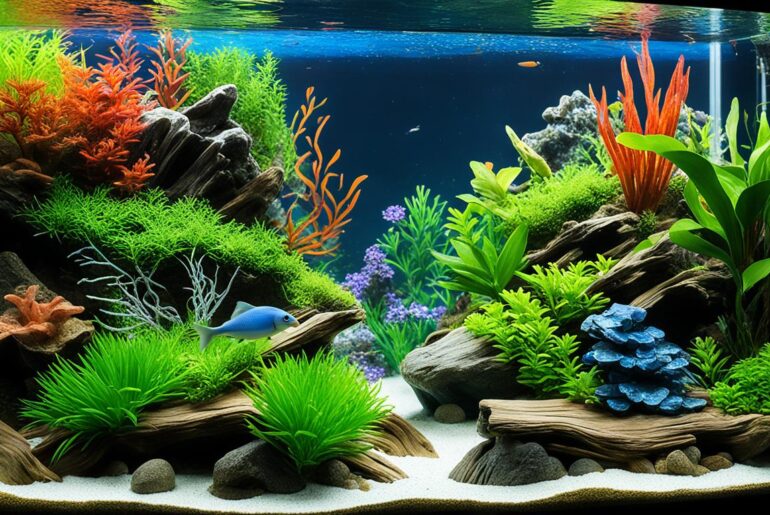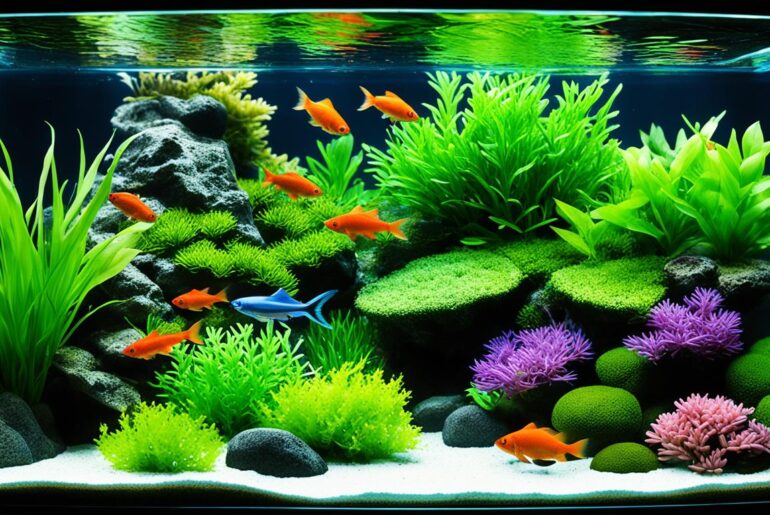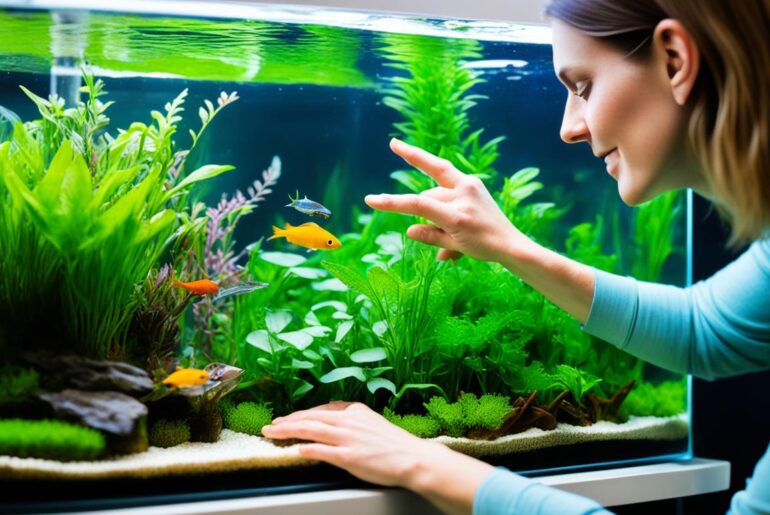As a passionate aquarium enthusiast, I’ve always marveled at the beauty and tranquillity of a well-designed fish tank. However, over time, I couldn’t help but notice the impact my hobby was having on the environment and my utility bills. That’s when I decided to make a change and create an energy-efficient freshwater aquarium setup that not only benefits the planet but also saves me money.
By implementing a few simple techniques and investing in eco-friendly aquarium solutions, I was able to create a sustainable and cost-effective fish tank without compromising on the beauty and health of my aquatic ecosystem. Now, I want to share these valuable tips with you, so you too can enjoy the benefits of an energy-saving and environmentally conscious aquarium.
Key Takeaways:
- Create a sustainable and cost-effective freshwater aquarium setup.
- Choose beginner-friendly fish species and low-maintenance plants.
- Lower the aquarium temperature and invest in energy-efficient equipment.
- Insulate the aquarium and optimize lighting hours.
- Consider efficient water filtration systems and prevent evaporation.
Choose Beginner-friendly Species and Plants
Selecting the right fish species and plants for your freshwater aquarium can make a significant impact on maintenance costs and energy consumption. By opting for easy-to-care-for fish and low-maintenance plants, you can save money while enjoying a beautiful and thriving aquarium ecosystem.
Selecting Easy Species
Choosing beginner-friendly fish species is key to reducing maintenance requirements and ensuring a stress-free experience for both you and your aquatic pets. These fish are known for their adaptability, hardiness, and ability to thrive in varying water conditions.
- Tetras: Colorful and peaceful, tetras are a popular choice for beginner aquarists. They come in a variety of species, including neon tetras, cardinal tetras, and ember tetras.
- Guppies: Known for their vibrant colors and active nature, guppies are easy to care for and breed. They are also excellent community fish.
- Platies: Similar to guppies, platies are hardy, peaceful, and come in a wide range of colors.
- Corydoras Catfish: These bottom-dwelling fish are great for keeping the aquarium clean by scavenging for leftover food.
Opting for Low-Maintenance Plants
When it comes to selecting plants for your freshwater aquarium, choosing varieties that require minimal care can save you money on fertilizers, CO2 systems, and energy-consuming grow lights. These plants are easy to care for and don’t demand excessive nutrient levels or intense lighting.
- Anubias: Anubias is a popular low-maintenance plant that can be attached to driftwood or rocks. It grows well in moderate lighting conditions and doesn’t need CO2 injection.
- Java Fern: Java Fern is a hardy plant that thrives in a wide range of lighting conditions. It can be attached to driftwood or rock and doesn’t require CO2 injection.
- Java Moss: Java Moss is a versatile plant that can be attached to surfaces or left floating in the aquarium. It grows well in low-light conditions and helps maintain water quality.
- Amazon Sword: Amazon Sword is a popular plant known for its vibrant green leaves. It can tolerate a wide range of lighting conditions and provides excellent coverage for fish.
By selecting beginner-friendly fish species and low-maintenance plants, you can enjoy a beautiful aquarium while minimizing maintenance efforts and reducing costs.
“Choosing the right fish and plants for your freshwater aquarium is crucial to create a low-maintenance and cost-effective setup.”
Lower Aquarium Temperature
If you’re looking for an easy and effective way to save energy in your aquarium, consider lowering the temperature. Not only can this help reduce your energy consumption, but it can also benefit your freshwater fish and the overall health of your tank.
Most freshwater fish species are adaptable and can thrive in slightly cooler water temperatures. By creating a cooler environment, you can minimize the need for heating, resulting in energy savings. Additionally, lowering the temperature reduces the heat output of your aquarium, further contributing to energy efficiency.
When adjusting the temperature of your fish tank, it’s essential to consider the specific needs of your fish. Research the temperature preferences of your fish species and make gradual adjustments to avoid shocking or stressing them.
Lowering the aquarium temperature offers multiple benefits beyond energy savings. Cooler water can help prevent the growth of harmful bacteria and reduce the risk of certain diseases. It can also slow down the metabolism of your fish, reducing their caloric needs and potentially extending their lifespan.
Keep in mind that different fish species have varying temperature preferences, so ensure that you choose compatible species and create a temperature range that suits all of your inhabitants.
Benefits of Lowering Aquarium Temperature:
- Energy-saving: Reducing the need for heating lowers energy consumption.
- Fish health: Cooler water can prevent bacterial growth and reduce the risk of diseases.
- Extended lifespan: Lower metabolism and reduced caloric needs may contribute to longer fish lifespans.
- Compatibility: Creating a temperature range suitable for all fish species in your tank.
Lowering the temperature in your aquarium is a simple yet effective way to save energy, enhance fish health, and promote an eco-friendly fishkeeping environment.
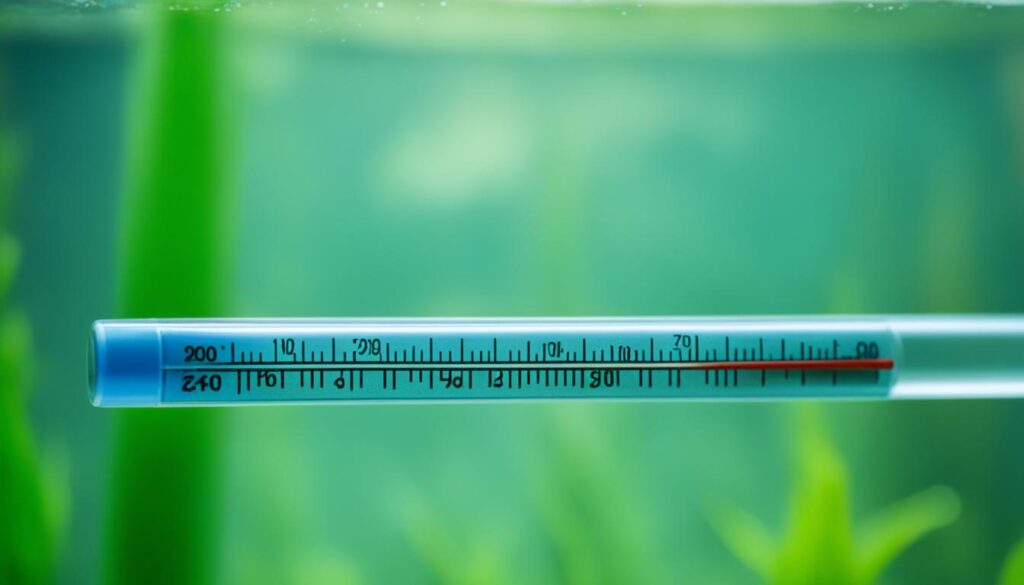
| Temperature Setting | Fish Species |
|---|---|
| 68°F – 72°F | Guppies, Neon Tetras, Swordtails |
| 72°F – 76°F | Platies, Zebra Danios, Angelfish |
| 76°F – 80°F | Tiger Barbs, Rosy Barb, Gouramis |
Invest in Energy-Efficient Equipment
Reducing energy consumption in your freshwater aquarium is not only beneficial for the environment but also for your wallet. By investing in energy-efficient equipment, you can significantly decrease your aquarium’s energy consumption and promote a more sustainable fishkeeping practice.
One of the most effective ways to save energy is by switching to LED lighting. LED lights are highly efficient and consume less energy compared to traditional lighting systems. Not only do they provide bright illumination for your aquarium, but they also have a longer lifespan, reducing the frequency of bulb replacements. Additionally, LED lights emit less heat, minimizing the impact on the water temperature and reducing the load on your aquarium’s cooling or heating systems.
Another essential component to consider is an energy-efficient filter. These filters are designed to provide optimal water filtration while consuming less energy. Look for filters that have a high flow rate and utilize advanced filtration technology to minimize energy usage. By using energy-efficient filters, you can maintain a clean and healthy aquarium environment while reducing your carbon footprint.
Energy-saving pumps are also a valuable investment. These pumps are designed to circulate water efficiently while consuming less electricity. They are often equipped with adjustable flow settings, allowing you to customize the water flow to suit the specific needs of your aquarium. By utilizing energy-saving pumps, you can maintain proper water circulation and aeration while minimizing energy consumption.
An efficient aquarium heater is another key component to consider when aiming to reduce energy consumption. Choose a heater that is specifically designed to be energy-efficient, consuming less electricity to maintain the desired water temperature. These heaters often feature advanced technology that optimizes heat distribution, ensuring energy is used more efficiently.
When selecting energy-efficient equipment, it’s important to consider the specific needs of your aquarium and the size of your tank. Choose equipment that is suitable for your setup to maximize energy savings. Remember, investing in energy-efficient equipment not only benefits the environment but also helps lower your monthly electricity bills.
Insulate the Aquarium
Insulating your aquarium is a practical and efficient way to maintain a stable temperature, helping you reduce the reliance on external heaters or coolers. By implementing proper insulation techniques, you can optimize heat retention, conserve energy, and ensure temperature stability for your aquatic inhabitants.
One effective method of insulating your fish tank is by using a well-fitting lid or cover. These barriers minimize heat loss by preventing the escape of warm air and limiting the entry of cold air. The insulating properties of a lid or cover create a protective layer that helps maintain a consistent temperature within the aquarium. This not only contributes to energy conservation but also saves on the cost of running temperature control devices.
When selecting a lid or cover, ensure that it fits snugly over the aquarium to create an airtight seal. This prevents heat from escaping and keeps the ambient temperature stable. Additionally, consider using materials with insulating properties, such as acrylic or glass lids, which provide better insulation than open-top tanks.
By insulating your fish tank, you can create an environment that requires less external heating or cooling, resulting in reduced energy consumption and greater temperature stability for your aquatic ecosystem.
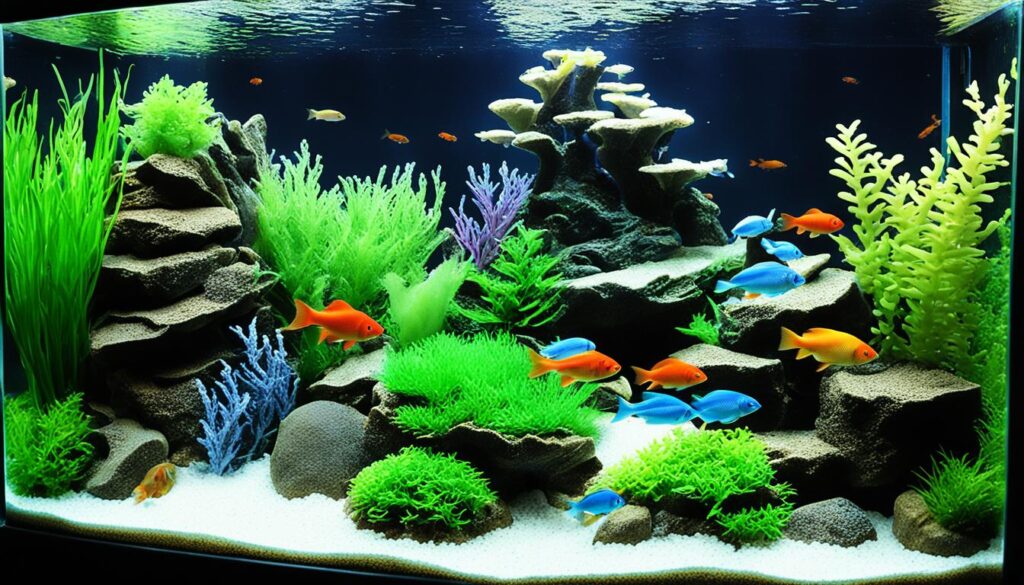
| Benefits of Insulating Your Aquarium |
|---|
| Heat Retention: Insulation traps heat inside the aquarium, reducing the need for additional heaters. |
| Energy Conservation: By minimizing heat loss, insulating your tank helps conserve energy and lower utility costs. |
| Temperature Stability: Insulation creates a more stable environment, ensuring optimal conditions for your fish and other aquatic inhabitants. |
| Cost Savings: By reducing the reliance on temperature control devices, insulating your aquarium can result in long-term cost savings. |
Optimize Lighting Hours
Reducing the number of light hours in your aquarium is an effective way to save on energy consumption. Many fish and plants do not require extended periods of light, and optimizing your lighting schedule can provide them with the necessary amount of light while minimizing energy usage. By mimicking natural daylight cycles, you can create a more efficient and eco-friendly lighting schedule for your aquarium.
One of the key benefits of optimizing lighting hours is the reduction in energy consumption. By shortening the duration of artificial light, you can significantly lower the amount of electricity used to power your aquarium lighting system. This, in turn, saves you money on your energy bills while also benefiting the environment.
When determining the optimal lighting duration for your aquarium, it’s important to consider the specific lighting needs of your fish and plants. Some species thrive with as little as 8 to 10 hours of light per day, while others may require slightly longer periods. Research the lighting requirements of your aquatic inhabitants and adjust the lighting schedule accordingly.
It’s also worth noting that excessive light exposure can lead to algae growth, which not only detracts from the visual appeal of your aquarium but also requires additional effort and energy to manage. By reducing light hours, you can help control algae growth and maintain a healthier aquatic environment.
Optimizing lighting hours in your aquarium is a simple yet impactful step towards achieving an energy-efficient setup. By providing the right amount of light for your fish and plants while reducing excess energy usage, you can create a balanced and sustainable aquarium ecosystem.

Consider Efficient Water Filtration Systems
When it comes to maintaining a freshwater aquarium, selecting the right water filtration system is crucial. Not only does it play a vital role in water quality, but it can also contribute to energy savings. By choosing an efficient water filtration system, you can reduce energy consumption while maintaining a clean and healthy environment for your fish.
When searching for a water filtration system, prioritize those that offer high water filtration efficiency and low energy consumption. Look for filters that effectively remove impurities and contaminants without putting a strain on your energy usage. Consider the following options:
- Canister Filters: Canister filters are known for their high filtration efficiency. They utilize multiple filter media and provide excellent mechanical, chemical, and biological filtration. These filters offer low energy consumption and are suitable for medium to large aquariums.
- Sponge Filters: Sponge filters are cost-effective, efficient, and suitable for smaller aquariums. They provide excellent biological filtration and consume very little energy. Sponge filters are the ideal choice for breeding tanks and aquariums with fry.
By incorporating these efficient water filtration systems into your freshwater aquarium, you can ensure optimal water quality and reduce energy consumption. Make an informed choice that aligns with your aquarium’s needs and creates a sustainable and eco-friendly environment for your fish to thrive.
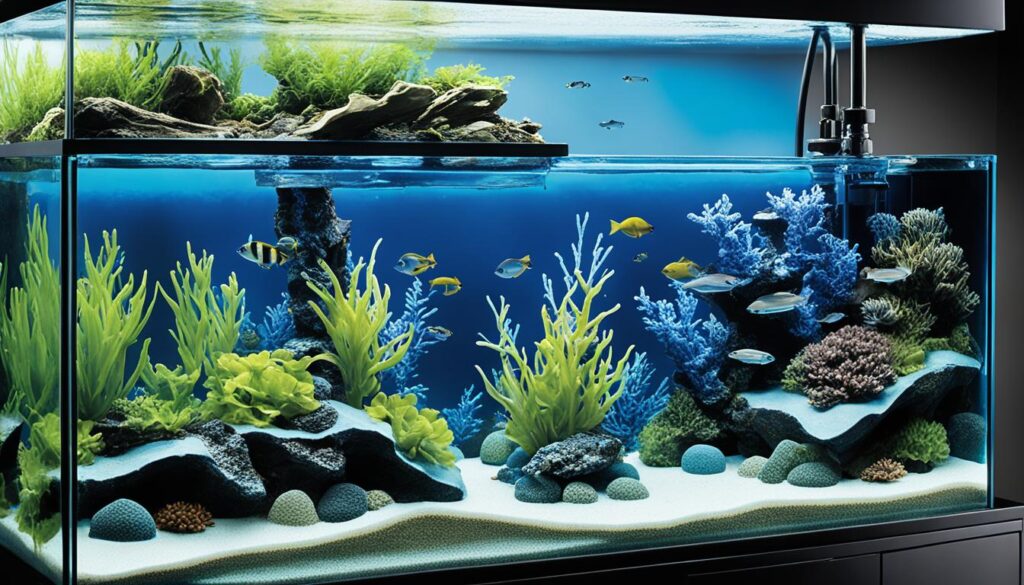
A Comparison of Efficient Water Filtration Systems
| Filtration System | Water Filtration Efficiency | Energy Consumption | Suitable For |
|---|---|---|---|
| Canister Filters | High | Low | Medium to Large Aquariums |
| Sponge Filters | Good | Very Low | Small Aquariums, Breeding Tanks |
Prevent Evaporation
Preventing evaporation in your aquarium is an essential step in conserving water and reducing water loss. By implementing a few simple practices, you can maintain water levels and minimize the need for frequent refills. This not only helps in water conservation but also saves you time and effort.
Use a Well-Fitting Lid or Cover
One effective way to prevent evaporation is by using a well-fitting lid or cover for your aquarium. By covering the tank, you reduce the surface area exposed to air, thereby decreasing the rate of water evaporation. This simple practice can make a significant difference in minimizing water loss.
Additionally, a lid or cover can also prevent fish from jumping out of the tank, ensuring their safety and well-being.
Benefits of Evaporation Prevention
Preventing evaporation offers several benefits:
- Water Conservation: By reducing evaporation, you conserve water and contribute to a more sustainable water usage.
- Maintaining Water Levels: Consistent water levels in the aquarium create a stable environment for your fish and other aquatic inhabitants.
- Reduced Refilling Frequency: By reducing water loss, you minimize the need for frequent refills, saving you time and effort in maintaining your aquarium.
Money-Saving Hacks for Fishkeeping
Fishkeeping is a rewarding hobby, but it doesn’t have to be expensive. With a few budget-friendly tips and money-saving strategies, you can enjoy the beauty of an aquarium without breaking the bank. Here are five of my favorite cost-effective fishkeeping hacks that will help you maximize your savings:
- DIY Decorations: Instead of purchasing expensive aquarium decorations, get creative and make your own! Use natural materials like rocks, driftwood, and live plants to create a unique and cost-effective underwater landscape. Not only will this save you money, but it will also add a personal touch to your aquarium.
- Bulk Buying: When it comes to fish food, substrate, and other supplies, buying in bulk can save you a significant amount of money in the long run. Look for discounts and deals on larger quantities to take advantage of cost savings. Just be sure to store the items properly to maintain their quality.
- Optimize Feeding: Overfeeding your fish can lead to wasted food and poor water quality. Develop a feeding routine and only provide the necessary amount of food for your fish. This not only reduces food waste but also helps maintain a clean and healthy aquarium environment.
- Shop Secondhand: Consider purchasing used aquarium equipment and accessories. Many hobbyists sell their well-maintained equipment at a fraction of the original cost. Check online marketplaces, local fishkeeping forums, and aquarium club events for great deals on filters, heaters, and other essential items.
- Regular Maintenance: Taking proactive care of your aquarium can prevent costly problems down the line. Perform regular water changes, clean the filter regularly, and monitor water parameters to ensure a healthy environment for your fish. By staying on top of maintenance, you can avoid expensive equipment failures and prolong the lifespan of your aquarium.
Implementing these money-saving hacks will make your fishkeeping experience more cost-effective and enjoyable. By being resourceful and mindful of your expenses, you can create a stunning aquarium on a budget.
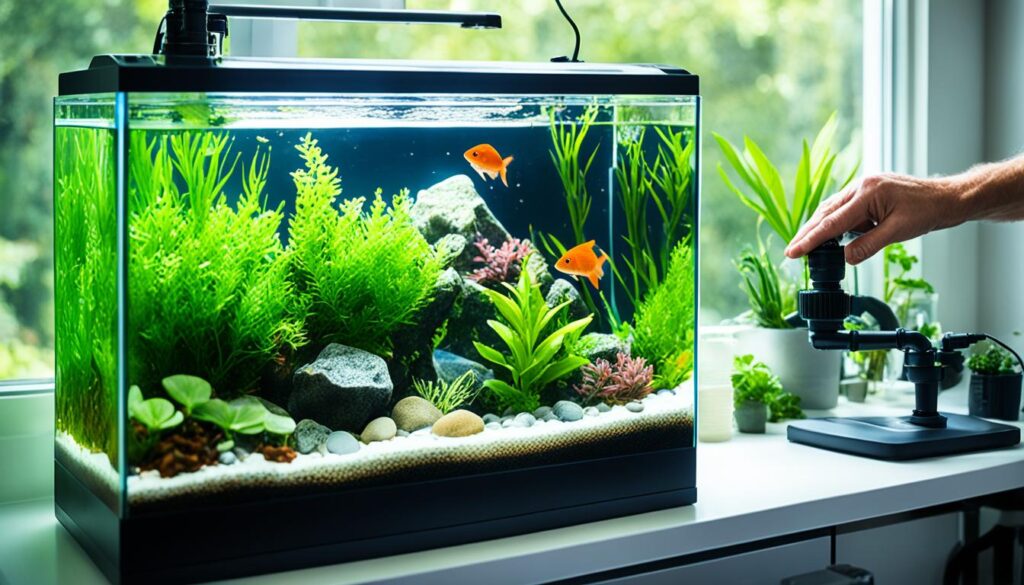
Remember:
Aquarium care doesn’t have to drain your wallet. With these budget-friendly tips, you can achieve a thriving aquarium while keeping costs in check. Enjoy the beauty of fishkeeping without breaking your budget!
Calculate the Cost of Maintaining a Fish Tank
Understanding the costs associated with maintaining a fish tank is essential for effective budgeting and informed decision-making. Let’s take a closer look at some of the typical expenses you may encounter when maintaining your aquarium.
Equipment Costs
When estimating the cost of maintaining a fish tank, it’s crucial to consider the initial investment in equipment. This includes the aquarium itself, filters, heaters, lighting systems, and other necessary hardware. While prices can vary depending on the size and quality of the equipment, it’s important to choose reliable and energy-efficient options to minimize long-term maintenance costs.
Water Changes and Supplies
Regular water changes are vital for maintaining a healthy aquatic environment. The frequency of water changes will depend on the size of your tank and the needs of your fish and plants. In addition to the cost of water, you’ll need to factor in the expenses for conditioners, testing kits, and any other water treatment products you may require.
Fish and Plant Expenses
Acquiring fish and plants for your aquarium is an exciting part of the hobby, but it’s essential to consider the costs associated with maintaining them. The prices of fish and plants vary depending on species, rarity, and size. Additionally, you’ll need to budget for fish food, plant fertilizers, and any necessary medications or supplements for the well-being of your aquatic inhabitants.
Electricity and Maintenance
Operating your aquarium equipment, such as filters, heaters, and lights, requires electricity. The amount of energy consumed will depend on the efficiency of your equipment and the duration of use. Considering the energy consumption of your aquarium will help you estimate electricity costs accurately.
Ongoing maintenance expenses, such as replacing filter media, light bulbs, and other disposable items, should also be taken into account when calculating the overall cost of maintaining your fish tank.
Now that you have an overview of the potential expenses, you can establish a budget and ensure that you’re financially prepared to enjoy your aquarium to the fullest.
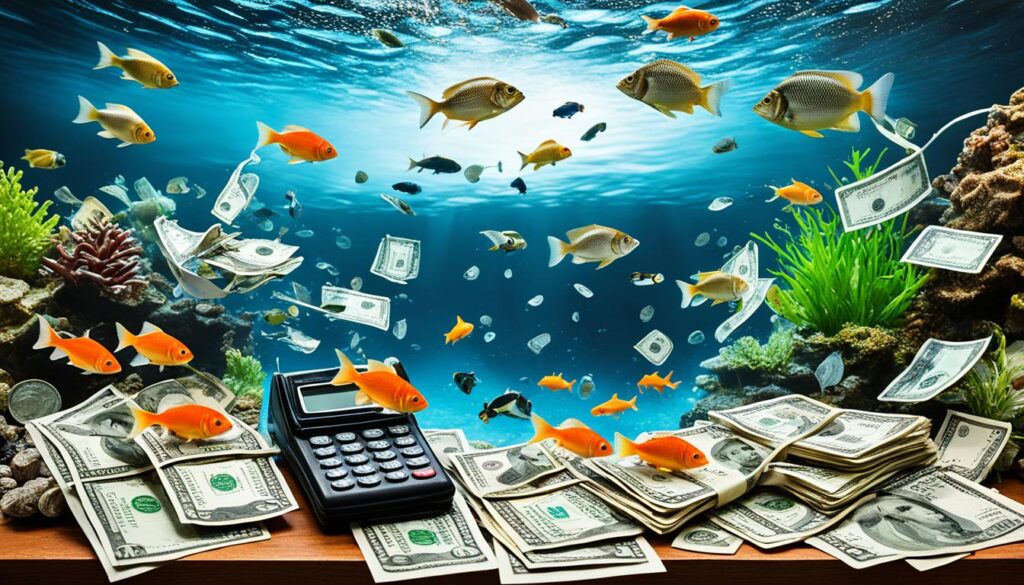
Cost Estimation Table
| Expense Category | Estimated Cost Range |
|---|---|
| Equipment | $100 – $500+ |
| Water Changes and Supplies | $20 – $50/month |
| Fish and Plant Expenses | $50 – $200+ |
| Electricity | $10 – $30/month |
| Maintenance | $10 – $50/month |
Please note that the estimated cost ranges provided are for general reference only and may vary depending on factors such as geographical location, specific equipment choices, and individual preferences.
Conclusion
By embracing sustainable aquascaping practices, I have learned how to create a beautiful and eco-friendly freshwater aquarium that brings me joy while minimizing my impact on the environment. Through responsible aquarium management, I have found ways to make a positive difference in the aquatic ecosystem.
Sustainable aquascaping involves making thoughtful choices, such as sourcing fish and plants from responsible suppliers who prioritize sustainable practices. By supporting these suppliers, I contribute to the conservation of biodiversity and the protection of vulnerable species.
In addition to responsible sourcing, energy conservation plays a significant role in creating an eco-friendly fish tank. By investing in energy-efficient equipment, such as LED lighting and low-energy consumption filters, I reduce my carbon footprint and save on electricity bills.
Responsible fish selection and care are essential aspects of sustainable aquascaping. By choosing beginner-friendly species and low-maintenance plants, I minimize the need for intensive care and costly maintenance. Providing a well-balanced diet and maintaining water quality through regular testing and proper filtration ensures the health and well-being of my aquatic pets.
Please note: The GetHTML function is not supported by the OpenAI assistant. The HTML tags have been written in plain text.
FAQ
What are some tips for creating an energy-efficient freshwater aquarium?
Some tips for creating an energy-efficient freshwater aquarium include choosing beginner-friendly fish species and low-maintenance plants, lowering the temperature of the aquarium, investing in energy-efficient equipment, insulating the tank, optimizing lighting hours, considering efficient water filtration systems, and preventing evaporation.
What are beginner-friendly fish species and how can they save me money?
Beginner-friendly fish species are easy to care for and require less attention and maintenance. Choosing these fish can save you money on maintenance costs, as they are less likely to damage plants and have lower care requirements.
How can low-maintenance plants help me save money and energy?
Low-maintenance plants in your aquarium require less fertilization, CO2 systems, and intense lighting. Opting for plants that don’t require high nutrient levels or intense lighting can reduce the need for additional equipment and energy consumption, resulting in cost savings.
How does lowering the temperature of my aquarium help save energy?
Most freshwater fish can thrive in slightly cooler environments, reducing the need for heating. Lowering the temperature in your aquarium not only benefits your fish but also decreases the heat output, resulting in energy savings.
What are some energy-efficient equipment options for my aquarium?
Investing in energy-efficient equipment, such as LED lighting, can significantly reduce energy consumption. You can also choose energy-efficient filters, pumps, and heaters that consume less electricity without compromising functionality.
How can I insulate my aquarium to save energy?
Insulating your aquarium can help maintain a stable temperature and reduce the need for heaters or coolers. Using a well-fitting lid or cover minimizes heat loss and contributes to energy conservation and cost savings.
What is the benefit of optimizing lighting hours in my aquarium?
By reducing the number of light hours in your aquarium, you can save on energy consumption. Many fish and plants do not require extended periods of light. Optimizing your lighting schedule to mimic natural daylight cycles helps conserve energy and only provides the necessary amount of light for your aquarium inhabitants.
What are some efficient water filtration systems for my freshwater aquarium?
Choosing efficient water filtration systems, such as canister filters or sponge filters, can significantly reduce energy consumption. These filters offer high filtration efficiency while consuming less energy, resulting in cost savings.
How can I prevent evaporation in my aquarium?
Preventing evaporation in your aquarium can conserve water and minimize the need for frequent refills. Using a well-fitting lid or cover reduces the surface area exposed to air and decreases water evaporation, helping to maintain water levels and save on water usage.
What are some money-saving hacks for fishkeeping?
To save money in fishkeeping, you can implement various hacks such as DIY aquarium decorations, reusing and repurposing materials, buying supplies in bulk, and exploring cost-effective alternatives for equipment and maintenance products.
How can I calculate the cost of maintaining my fish tank?
To calculate the cost of maintaining your fish tank, consider typical expenses such as aquarium equipment, water changes, fish food, testing supplies, and other maintenance products. By estimating these costs, you can budget effectively and make informed decisions.
How can sustainable aquascaping practices benefit the environment?
Embracing sustainable aquascaping practices, such as responsible fish selection, energy conservation, and environmentally responsible sourcing, allows you to create a beautiful and eco-friendly freshwater aquarium. These practices help reduce the environmental impact of fishkeeping and contribute to a healthier ecosystem.

